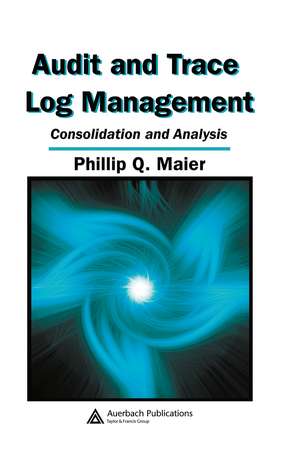Audit and Trace Log Management: Consolidation and Analysis
Autor Phillip Q. Maieren Limba Engleză Hardback – 5 apr 2006
This volume enables you to gain the knowledge, perspective, and insight needed to independently implement a successful audit and monitoring management system tailored to the unique requirements of your organization.
Preț: 562.57 lei
Preț vechi: 817.88 lei
-31% Nou
Puncte Express: 844
Preț estimativ în valută:
107.68€ • 110.96$ • 90.90£
107.68€ • 110.96$ • 90.90£
Comandă specială
Livrare economică 10-24 februarie
Doresc să fiu notificat când acest titlu va fi disponibil:
Se trimite...
Preluare comenzi: 021 569.72.76
Specificații
ISBN-13: 9780849327254
ISBN-10: 0849327253
Pagini: 186
Ilustrații: 18 b/w images and 16 tables
Dimensiuni: 156 x 234 x 17 mm
Greutate: 0.46 kg
Ediția:1
Editura: CRC Press
Colecția Auerbach Publications
ISBN-10: 0849327253
Pagini: 186
Ilustrații: 18 b/w images and 16 tables
Dimensiuni: 156 x 234 x 17 mm
Greutate: 0.46 kg
Ediția:1
Editura: CRC Press
Colecția Auerbach Publications
Public țintă
Academic and Professional Practice & DevelopmentCuprins
Introduction to audit logging. The “why” of consolidated audit logging. Taking stock, what is in place today. Deciding what to capture and how to do it. Setting up correlation rules, putting your assembled infrastructure to work. Security event management, generating reports from your system. Setting security alert levels and escalation processes. Pulling it all together and making your case.
Recenzii
“There are only a few books that I would recommend every security professional keep on the shelf, … this is one of them. It was written by someone who has lived the numbing nightmare of surveying the endlessly proliferating sources of event data in a modern enterprise, of identifying what must be collected, how it should be collected, filtered and stored, and what should be done with it. Most importantly, Maier kept careful notes along the way and has provided a guidebook that will help those of us who follow.”
—Richard Austin, MSC, CISSP, MCSE, Hewlett Packard, in IEEE Cipher, January 2007
“Ultimately the readers are provided with a roadmap and a “how to” guideline leading to the successful implementation of a state-of-the-art auditing and monitoring system. Most will want to read it from cover to cover, and also add it to their bookshelves for frequent reference. …Armed with the knowledge from this book, you will be able to champion and guide your organization through a disciplined and well-defined audit and monitoring project. It isn’t a stretch to be able further to design and implement the system while fulfilling a diverse set of requirements and organizational needs.”
Linda L. McGhie, CISSP, CISM, PCS ISO/Risk Manager, Wells Fargo Bank
—Richard Austin, MSC, CISSP, MCSE, Hewlett Packard, in IEEE Cipher, January 2007
“Ultimately the readers are provided with a roadmap and a “how to” guideline leading to the successful implementation of a state-of-the-art auditing and monitoring system. Most will want to read it from cover to cover, and also add it to their bookshelves for frequent reference. …Armed with the knowledge from this book, you will be able to champion and guide your organization through a disciplined and well-defined audit and monitoring project. It isn’t a stretch to be able further to design and implement the system while fulfilling a diverse set of requirements and organizational needs.”
Linda L. McGhie, CISSP, CISM, PCS ISO/Risk Manager, Wells Fargo Bank
Descriere
According to one reviewer, “Armed with the knowledge from this book, you will be able to champion and guide your organization through a disciplined and well-defined audit and monitoring project.” This savvy manual offers a wealth of information in the form of process walkthroughs. It provides the tools, templates, and instructions to assist a variety of organizations in conducting thorough reviews of existing logging systems, discusses how to determine what information to capture and how to do it, reviews the challenges of archiving and the retrieval of archived data, offers options for monitoring and forensic audits, and examines the use of both off-the-shelf and internally developed software.
